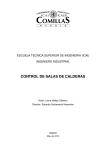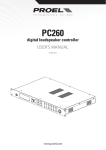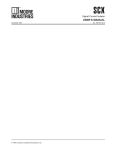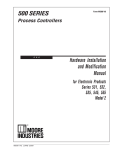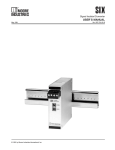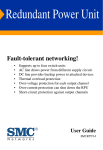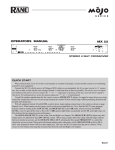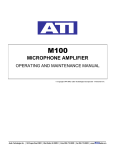Download Autek Research QF-1A User manual
Transcript
Autek Research QF-1A Active Audio Filter User Manual Each filter is thoroughly tested twice before shipment. Please read the instructions carefully for best results, and save them for future reference. If you require adaptors or other parts not supplied, please obtain these locally as we do not stock them. This switch and the Selectivity/Frequency controls adjust the response of the main filter (all but the Aux Notch). PEAK (band-pass) passes a narrow band of frequencies, and rejects others -- just the opposite of NOTCH. LOWPASS passes low frequencies, while rejecting high frequencies (e.g. hiss). HIGHPASS is the opposite of LOWPASS: it passes high frequencies, while rejecting low frequencies. An exception occurs at high selectivity, where LOWPASS and HIGHPASS take on some of the characteristics of PEAK. A. INITIAL HOOKUP 3. Selectivity Control Plug the QF-1A into your receiver’s phone jack or speaker output. Any impedance is O.K. Obtain an adaptor if size is not compatible. Connect any impedance phones or speaker to the rear-panel phone jack output. To avoid hum or distortion with “Hi-Fi” headphones, use a series resistor of about 46 ohms. (See section: “In case of trouble”.) In PEAK, this control determines the filter bandwidth. Peak bandwidth as narrow as 14 Hz (- 3 dB) or 20 Hz (-6 dB) is available at 300 Hz. The bandwidth gradually increases to 20 Hz at an 800 Hz center frequency, and reaches a few hundred Hz at the highest frequency setting (2500 Hz). This bandwidth increase is deliberate and makes for easiest tuning. At min. Sel., the filter is almost flat. Your Autek QF-1A audio filter is the product of several years of development by the originator of commercial active audio filters for shortwave communications since (1972). The filter input may also be connected to the receiver speaker wires. Just be sure the input cable shield (connected to QF-1A chassis) is connected to the grounded speaker wire; otherwise, there may be hum. Note: This is rare, but some Barlow-Wadley radios and CB sets require a load resistor across their speaker or phone output for a DC return. The filter’s high input impedance does not provide this. Try a resistor in the range of 10 to 100 ohms installed in the radio across the output being used. Otherwise the set may appear to be dead, as the output stage bias is wrong. B. FAMILIARIZATION The filter selects or rejects certain frequency components of signals you tune in. This allows it to reject undesired signals, such as noise and interference, while passing the desired signal, so long as the noise and signal are not on the same frequency. This frequency selection/rejection is optimized with 5 controls: In NOTCH and LOWPASS, the panel suggests the best settings. More selectivity rotation (clockwise) makes the notch narrower, and shallower, hence harder to tune: in LOWPASS and HIGHPASS, excessive selectivity rotation can lead to ringing at some frequencies. The ideal “theoretical” best selectivity for least peaking in LOWPASS and HIGHPASS occurs when the selectivity control is rotated about two-thirds the frequency control, i.e. if the frequency control is rotated 50%, rotate the selectivity control about 30%. However, this “rule of thumb” should be broken under many conditions (see Tables 1 and 2). 4. Frequency Control This tunes the main filter frequency from about 250 to 2500 Hz, the entire usable communications range for voice, CW, and digital (RTTY, SSTV, etc.) signals. 5. In/Out (ON/OFF) Switch 1. Auxiliary Notch Frequency A notch rejects a narrow band of frequencies, such as a whistle, or a code station. The Aux Notch is present at all times. To effectively disable it, set it to either 80 or 11,000 Hz. The Aux Notch is very wide, for easiest tuning, and very deep. Its 135:1 frequency range is by far the widest ever available for communications, and should cover any signal. 2. Function Select Switch (PK, NOTCH, LP, HP) This turns off the AC power and bypasses the filter. There is an unavoidable click when thrown due to the power supply charging or discharging. The filter draws less than 1/2 watt if left on accidentally. Note: Volume is adjusted with your receiver’s gain control. Gain at high selectivity in PEAK (and LP) is high, and very little noise comes through; so keep receiver gain low under these conditions to avoid saturation of the QF-1A power amp (distortion) when the desired CW signal comes through! C. USEFUL ADJUSTMENTS PICKUP OF YOUR TRANSMITTED SIGNAL See Tables 1 and 2. This should be extremely rare with the QF-1A, as layout and RF bypass caps are excellent, and show no sign of RF at 2 KW with the antenna 20 feet away and the cover off, in our tests. However, some shacks, especially using end-fed antennas in the shack, and/or extreme RF on the 115 VAC AC line may possibly interfere with any audio gear. Solutions in this case are: 1) Plug the filter into an outlet away from the transmitter. 2) Move the filter physically a few feet away from the strong RF source; experiment. 3) Try connecting pieces of hookup wire between various units in the shack to eliminate ground loops, e.g., transceiver/linear, linear/filter, speaker case/filter, etc. until all possible combinations have been tried. 4) Use a good water pipe ground to your rig. 5) Try an L/C RFI AC line filter available at (most) electronic distributors. 6) Read more in radio handbooks. The above measures are rarely necessary as the QF-1A has been designed for use in high-power transmitting stations. So, if you have a problem, you must solve it in your shack; and all shacks are different. D. IN CASE OF TROUBLE We carefully test all filters. Most problems occur when first used due to improper connection (read instructions again) or misunderstanding of operation. The following are most common: HUM OR DISTORTION WHEN USING HEADPHONES Hum generated in the QF-1A is normally barely audible with a speaker unless you place your ear within a few inches of the speaker. However, hum and distortion may be troublesome if you use 4-8 ohm “Hi-Fi” headphones, which are much too sensitive. To cure this (and improve “Hi-Fi” listening as well!) connect a 47 ohm resistor in series with this type of headphones. HUM WITH SPEAKER. BATTERY OPERATION DESIRED Usually this comes from your receiver. The QF-1A loads the receiver output much less than a speaker or phones. Therefore, you may find that switching the filter “on” produces hum, although no hum is heard in the filter “off” (bypass) position. This may simply be because the filter is not loading down the receiver as much. To see if the filter is really causing the hum, pull the filter input jack out of your receiver (not the same as switching to bypass!). If the hum goes away, or is reduced to nothing, with the filter input jack lying on the table, then the hum is coming from the receiver, and being emphasized because of the light loading by the filter input. Several solutions are indicated: 1) Check for good contact between the filter input plug and receiver jack. 2) Especially if the receiver phone jack is on an auxiliary speaker, try connecting some hookup wire between the speaker case and the receiver/transceiver chassis, or between the filter chassis. 3) Try connecting a 10 to 47 ohm resistor across the receiver phone jack or other output to load it down. Locate the rectifier diodes, D1 and D2, on the schematic. These are directly forward of the right transformer screw (as viewed from the front of the unit). Connect +12 to +14 VDC to the right side of either diode (the side with the band on the diode). Connect the battery ground to the filter chassis ground. Note: reversal of battery polarity, even for an instant, will burn out the filter -- not covered by warranty. Table 1 USEFUL ADJUSTMENTS Your QF-1A can “imitate” the response of virtually any filter with fixed response, at any price, and give an infinite number of other useful responses, as well. Truly, if the QF-1A can’t pull the signal out, no other filter can either! However, the QF-1A flexibility means that ever experienced operators will need some time to learn how to best use all the controls. The following table will aid you. IMPORTANT: Don’t give up on a setting because it doesn’t seem to help. Tomorrow with different conditions, this setting may turn out to be just what’s needed. Condition Desired CW Signal Useful Adjustments (See Note 1 for Aux Notch setting) PEAK: Casually listen with 7 to 10 o’clock selectivity, yielding a relatively “wide” 80 to 120 Hz bandwidth. Adjust frequency for desired CW note. Gradually increase selectivity and touch up frequency to match conditions. There is much confusion among HAMS about “ringing” of a CW filter, mainly caused by manufacturers of filters without the narrow ultimate selectivity of the QF-1A. Basically, here is the truth: ALL filters will produce audible ringing at bandwidths below 80 to 120 Hz, (and many poorly designed filters will ring even at wider bandwidths.) So the only way to eliminate ringing is to use a wide bandwidth (low selectivity on the QF-1A.) On the other hand, a CW signal has a bandwidth less then 10-20 Hz, so a very narrow filter can pass the entire CW signal and greatly reduce interference - but at the expense of ringing. The QF-1A gives you your choice (at considerable increase in manufacturing complexity.) High selectivity will be found to be invaluable in very heavy QRM or pileups, allowing you to hear signals inaudible at wider bandwidths, but high selectivity is not as useful in thermal noise. Note that gain at the peak increases at high selectivity, while background noise is reduced. So keep receiver audio gain low at high selectivity to avoid blasting when desired signal comes through the narrow “slot.” LOWPASS: Produces an effect similar to peak at high selectivity. Ignore LP sel. Panel markings for CW reception. If you listen to CW at low note (more than 12 o’clock freq. Rotation), you may find that you prefer LOWPASS. But LP is wider, and gain varies more. Voice Signal with Splatter Voice Signal (Moderate interference) Multiple Whistles or CW LOWPASS: Adjust selectivity, as on panel, rotate frequency for best compromise between rejection of splatter and rejection of desired signal. Frequency rotations beyond 8-10 o’clock rejects desired signal heavily, making it sound “bassy”. The idea is to find the best cutoff frequency, to maximize copy. If splatter completely covers desired signal, or if tow signals are on same frequency, the situation is impossible, and no known method of signal processing will work. PEAK: This position, at moderate selectivity of 7-9 o’clock, and frequency adjust for best copy, can sometimes clean up signals and give more “presence.” HIGHPASS: Full frequency rotation (250) Hz and 3-5 o’clock selectivity, along with AUX. NOTCH at 9 o’clock can give greater presence under some conditions. To reject “lows” or hum. set frequency as little as 11 o’clock, with selectivity rotated about 2/3 of frequency. Normally, AUX NOTCH is used. But the MAIN NOTCH is deeper (to 70 dB), and can be made narrower (at high selectivity). Use notch sel. Shown on panel. The notch is not as deep at high selectivity, so use minimum sel. Rotation consistent with least rejection of desired signal. Note: To help find the notch frequency, momentarily switch to PEAK at high sel., peak the whistle, then switch back to notch at moderate selectivity. Touchup whistles, or CW, or teletype QRM, use both main and Aux. notch Table 1 (continued) Weak CW An AC voltmeter, or scope, across the filter output is a big help in peaking weak CW signals. A “flat” response is approximated with aux. Notch at 11,000 and main filter as follows: Strong Signal PEAK: Freq. = 12 o’clock; Sel. = Min. NOTCH: Freq. = 2500; Sel. = Max LOWPASS: Freq. = 2500; Sel. = Min. HIGHPASS: Freq. = 250; Sel. = 2 o’clock Note: Even with these settings the filter contains additional fixed rolloffs below 250 Hz. And above 2500 Hz., so is not intended for “Hi-fi” applications, only communications. For RTTY, SSTV, etc. reject low frequencies using HIGHPASS sel. And freq. About 10-12 o’clock (experiment.) Or use notches to reject CW, etc. RTTY, SSTV and Misc. Line noise, Ignition, or other static You will doubt discover other settings for voice, CW, etc. not in this table, but useful under some conditions or with you own ear preferences. There is a conceivable use for almost all of the infinite number of settings under some conditions, and with some signals. The QF-1A will produce some improvement due to narrower bandwidth, especially on CW, but nothing dramatic on voice. The only really good solutions are a good I.F. Noise Blanker in your receiver, or a beam antenna. Even I.F. blankers are generally ineffective except car ignition noise – and may help a little on line noise. Audio Noise Limiters (not to be confused with I.F. Blankers) can be built with two diodes (See Radio Amateurs Handbook), but we found them to cause distortion and virtually worthless for noise, so they are not included, despite their negligible cost. Note 1: AUX. NOTCH SETTING. It’s usually best to leave the Aux. Notch at 11,000 until the main filter is adjusted for best results. Set it at about 9 o’clock for voice, where it rejects a wide band or hiss and high-frequency whistles. Set it to reject any loud whistle or CW at other frequencies. Table 2 (Condensed Version of Table 1): Condition CW Voice Splatter Voice Voice Whistle or other QRM Two Whistles RTTY, SSTV Function PEAK or LP LOWPASS PEAK HP To Reject NOTCH HP Selectivity 8 o’clock or more As on panel 7 to 9 o’clock 3 to 5 o’clock / 11 up N/A As on panel 10 to 12 o’clock Main Frequency For best copy 7-11 o’clock For best clarity 250 Hz / 11 up (use aux. notch to reject whistle) (use aux. notch to reject whistle) Same as sel. (or notch if whistle) Table 2A (User Defined Settings): Useful chart for user defined settings – Keep for your records. CONDITION AUX. NOTCH FUNCTION SELECTIVITY FREQUENCY E. WARRANTY AND RETURNS G. ALIGNMENT We back our products better than most companies -not just 90 days, but one full year. The circuit has two alignments. Neither should require adjustment unless disturbed, especially the Main filter tracking alignment, which is quite non-critical. The Aux Notch Depth alignment is more critical and sensitive. LIMITED ONE YEAR WARRANTY: Autek Research warrants to the original consumer purchaser that its products shall be free of defects in workmanship and materials from one year from original date of purchase. WARRANTY LIMITATIONS: This limited warranty does not cover, and we are not responsible for, any product which has been modified by the owner, or any malfunction or failure resulting from improper use improper applied voltage, improper service or repair by the owner or his agent, or from abuse, neglect accident, lightning damage, fire, use contrary to instructions, or other causes beyond the control of Autek Research. This warranty is made to the original consumer purchaser only, and is effective only upon presentation of documented evidence of provable original date of purchase. This warranty covers only Autek products, used for purposes as advertised. We are not responsible for incidental or consequential damages. Some states do not allow exclusion or limitation of incidental or consequential damages, so the above limitation or exclusion may not apply to you. This warranty gives you specific legal rights, and you may also have other rights which vary from state to state. F. REPAIR OF OLDER UNITS The Autek QF-1A has not been manufactured since the 1990’s and we no longer service these units. DO NOT return for repair! We also do not stock replacement parts. However, most components are not critical and are standard parts. For example, all fixed resistors are 5% ¼, watt. Tolerance on capacitors is not critical. Most parts, including the IC's , should be available at (most) electronic distributors, except for the selectivity and frequency dual pots. These pots were specially made for us and are log-taper. We know of no modern source of pots that plug into the board like the originals. Also, if the function switch plugs into the board it was custom-made. If the pots or switches are noisy, try spraying them with contact cleaner available from (most) electronic distributors to remove dust and dirt buildup. Keep the input signal low, to avoid saturation. A scope is recommended at the filter output for most accurate alignment, although an AC voltmeter, or even the ear, can produce acceptable results. The alignment frequency of 800 Hz produces best results over the entire filter range. However, if you desire best results at another frequency far removed from 800 Hz, i.e. 2000 Hz, it may be better to align the filter at the frequency of most interest. 1. Aux Notch Depth Alignment; Adjusted by the 10K trim-pot near the left side of the circuit board – behind the Aux Notch pot and slightly to the right. Feed in a signal at approx. 800 Hz (not critical). Your receiver’s calibrator beat note, or a signal generator may be used. 800 Hz is an average frequency for CW reception, and occurs at about 10 ‘o clock rotation of the MAIN frequency. Then adjust the trim pot for minimum signal. Now touch up the Aux Notch freq. and repeat the trim pot adjustment for minimum signal. Continue adjusting until no further improvement is noted. 2. Main Filter Tracking Alignment; There are two complete filters in series in the main filter. These filters are adjusted to track by this alignment. The alignment trim pot is directly behind the main (250 2500 Hz) frequency control on the right side of the board. Feed a signal at approx. 800 Hz (not critical) into the filter. Select “peak” and rotate Selectivity full (20 Hz setting). Set the Aux Notch at 11,000. Peak the signal with the main freq. control. Then adjust the trim pot for max. response. Readjust the main freq. and trimpot for max. response. Repeat until no further improvement in response is noted. Note: Alignment is the responsibility of the owner. H. LATE NOTES K. CREDITS If you wish the QF-1A to drive a speaker in “bypass” you must obviously connect the QF-1A input to a rig output which is capable of driving a speaker. (Some headphone outputs, but not all, can drive a speaker). When the filter is “on” virtually any high-level rig output can drive it. Original documentation provided by Autek Research. Portions rewritten and PDF file compiled by AG4RC between December-2006 & Janurary-2007 However, in “bypass” the rig’s output is connected directly to the QF-1A output jack - The rig must be capable of driving the speaker, if any, connected to the QF-1A output! I. REIALIBILITY The QF-1A has proved to be extremely reliable. In the past most units returned had nothing wrong with them. RF pickup seems to have been virtually eliminated, however if pickup should occur, we emphasize again that there is nothing wrong with your unit. Any problem must be solved in your shack. (See section: “In case of trouble”.) Reports are that all owners have been successful, usually by eliminating ground loops, or using an AC line filter, in these rare stubborn cases. J. TECHNICAL SUPPORT Please utilize on-line Amateur (HAM) radio web sites for questions regarding operation of this unit beyond the scope of this documentation. Most HAM radio sites have message forums (Q&A databases) that are frequently viewed by experienced knowledgeable people. L. DISCLAIMER THIS DOCUMENTATION WAS CHECKED FOR ERRORS PRIOR TO PUBLISHING. HOWEVER: THE AUTHOR(S) DO NOT ASSURE AND/OR GUARANTEE 100% ACCURACY AND/OR ASSUME ANY RESPONSIBILITY OF INACCURACY OF THIS DOCUMENTATION. THIS DOCUMENTATION IS INTENDED FOR REFERENCE ONLY. YOU ARE RESPOSIBLE TO FIRST VERIFY BEFORE RELYING ON ANY INFORMATION PROVIDE IN THIS DUCUMENTATION. Inside View of Autek QF-1A (Component Placement) Illustration shown includes after market modifications: DC power input jack connected to ON/OFF switch, LED power “ON” indicator, and audio input jack. Illustration intended for standard component placement in reference to schematic diagram. Bottom View of Autek QF-1A PC Board As illustrated: Top-Right control = R4 (Aux Notch) and Bottom-Left 14-pin IC = U3











